Thermomechanical Peridynamic Modeling for Ductile Fracture
Abstract
1. Introduction
2. Thermal Elastoplastic Bond-Based Peridynamic Model
3. Thermoelastic Hybrid Peridynamics and Classical Continuum Mechanics (PD-CCM) Model
3.1. Governing Equations
- Kinematic admissibility and compatibility
- Static admissibility
- Constitutive equations
3.2. Stiffness/Thermal Modulus Constraint Equations
- If and only if , and , , the model is restricted to the pure CCM model at point . Then the elastic energy density at point can be written as Equation (17)
4. Plastic-Fracture Calculations
5. Numerical Examples
5.1. Example 1: GH4099 Superalloy Structure
5.2. Example 2: Four-Point Bending Beam
6. Conclusions
Author Contributions
Funding
Institutional Review Board Statement
Informed Consent Statement
Data Availability Statement
Conflicts of Interest
References
- Li, Y.F.; Zeng, X.G.; Chen, H.Y. A Three-dimensional dynamic constitutive model and its finite element implementation for NiTi alloy based on irreversible thermodynamics. Acta Mech. Solida Sin. 2019, 32, 356–366. [Google Scholar] [CrossRef]
- Liang, W.; Hu, X.; Zheng, Y.; Deng, D. Determining inherent deformations of HSLA steel T-joint under structural constraint by means of thermal elastic plastic FEM. Thin-Walled Struct. 2020, 147, 106568. [Google Scholar] [CrossRef]
- Fan, Z.X.; Kruch, S. A comparison of different crystal plasticity finite-element models on the simulation of nickel alloys. Mater. High Temp. 2020, 37, 328–339. [Google Scholar] [CrossRef]
- Silling, S.A. Reformulation of elasticity theory for discontinuities and long-range forces. J. Mech. Phys. Solids 2000, 48, 175–209. [Google Scholar] [CrossRef]
- Wu, C.T.; Ren, B. A stabilized non-ordinary state-based peridynamics for the nonlocal ductile material failure analysis in metal machining process. Comput. Methods Appl. Mech. Eng. 2015, 291, 197–215. [Google Scholar] [CrossRef]
- Zhan, J.; Yao, X.; Han, F.; Zhang, X. A rate-dependent peridynamic model for predicting the dynamic response of particle reinforced metal matrix composites. Compos. Struct. 2021, 263, 113673. [Google Scholar] [CrossRef]
- Askari, A.; Azdoud, Y.; Han, F.; Lubineau, G.; Silling, S. 12-Peridynamics for analysis of failure in advanced composite materials. In Numerical Modelling of Failure in Advanced Composite Materials; Hallett, S.R., Camanho, P.P., Eds.; Woodhead Publishing: Sawston, UK, 2015; pp. 331–350. [Google Scholar]
- Bobaru, F.; Foster, J.T.; Geubelle, P.H.; Silling, S.A. (Eds.) Handbook of Peridynamic Modeling; Advances in Applied Mathematics; Chapman and Hall/CRC: London, UK, 2016. [Google Scholar]
- Ha, Y.D.; Bobaru, F. Characteristics of dynamic brittle fracture captured with peridynamics. Eng. Fract. Mech. 2011, 78, 1156–1168. [Google Scholar] [CrossRef]
- Han, F.; Lubineau, G. Coupling of nonlocal and local continuum models by the Arlequin approach. Int. J. Numer. Methods Eng. 2012, 89, 671–685. [Google Scholar] [CrossRef]
- Agwai, A.; Guven, I.; Madenci, E. Damage prediction for electronic package drop test using finite element method and peridynamic theory. In Proceedings of the Electronic Components & Technology Conference, San Diego, CA, USA, 26–29 May 2009. [Google Scholar]
- Kilic, B.; Madenci, E. Coupling of peridynamic theory and the finite element method. J. Mech. Mater. Struct. 2010, 5, 707–733. [Google Scholar] [CrossRef]
- Oterkus, E.; Madenci, E.; Weckner, O.; Silling, S.A.; Bogert, P.; Tessler, A. Combined finite element and peridynamic analyses for predicting failure in a stiffened composite curved panel with a central slot. Compos. Struct. 2012, 94, 839–850. [Google Scholar] [CrossRef]
- Liu, W.Y.; Hong, J.W. A coupling approach of discretized peridynamics with finite element method. Comput. Methods Appl. Mech. Eng. 2012, 245–246, 163–175. [Google Scholar] [CrossRef]
- Lubineau, G.; Azdoud, Y.; Han, F.; Rey, C.; Askari, A. A morphing strategy to couple non-local to local continuum mechanics. J. Mech. Phys. Solids 2012, 60, 1088–1102. [Google Scholar] [CrossRef]
- Azdoud, Y.; Han, F.; Lubineau, G. The morphing method as a flexible tool for adaptive local/non-local simulation of static fracture. Comput. Mech. 2014, 54, 711–722. [Google Scholar] [CrossRef]
- Yang, D.; He, X.Q.; Yi, S.; Deng, Y.; Liu, X.F. Coupling of peridynamics with finite elements for brittle crack propagation problems. Theor. Appl. Fract. Mech. 2020, 107, 102505. [Google Scholar] [CrossRef]
- Shen, S.K.; Yang, Z.H.; Cui, J.Z.; Zhang, J. Dual-variable-horizon peridynamics and continuum mechanics coupling modeling and adaptive fracture simulation in porous materials. Eng. Comput. 2022, 1–21. [Google Scholar]
- Anicode, S.V.K.; Madenci, E. Direct coupling of dual-horizon peridynamics with finite elements for irregular discretization without an overlap zone. Eng. Comput. 2023, 1–31. [Google Scholar] [CrossRef]
- Macek, R.W.; Silling, S.A. Peridynamics via finite element analysis. Finite Elem. Anal. Des. 2007, 43, 1169–1178. [Google Scholar] [CrossRef]
- Madenci, E.; Oterkus, S. Ordinary state-based peridynamics for plastic deformation according to von Mises yield criteria with isotropic hardening. J. Mech. Phys. Solids 2016, 86, 192–219. [Google Scholar] [CrossRef]
- Liu, Z.M.; Bie, Y.H.; Cui, Z.Q.; Cui, X.Y. Ordinary state-based peridynamics for nonlinear hardening plastic materials’ deformation and its fracture process. Eng. Fract. Mech. 2020, 223, 106782. [Google Scholar] [CrossRef]
- Tong, Y.; Shen, W.Q.; Shao, J.F. An adaptive coupling method of state-based peridynamics theory and finite element method for modeling progressive failure process in cohesive materials. Comput. Methods Appl. Mech. Eng. 2020, 370, 113248. [Google Scholar] [CrossRef]
- Liu, S.; Fang, G.D.; Fu, M.Q.; Yan, X.Q.; Meng, S.H.; Liang, J. A coupling model of element-based peridynamics and finite element method for elastic-plastic deformation and fracture analysis. Int. J. Mech. Sci. 2022, 220, 107170. [Google Scholar] [CrossRef]
- Alebrahim, R.; Marfia, S. A fast adaptive PD-FEM coupling model for predicting cohesive crack growth. Comput. Methods Appl. Mech. Eng. 2023, 410, 116034. [Google Scholar] [CrossRef]
- Yang, X.W.; Gao, W.C.; Liu, W.; Li, F.S. A dynamic coupling model of peridynamics and finite elements for progressive damage analysis. Int. J. Fract. 2023, 241, 27–52. [Google Scholar] [CrossRef]
- Liu, Q.Q.; Wu, D.; Madenci, E.; Yu, Y.; Hu, Y.L. State-Based peridynamics for thermomechanical modeling of fracture mechanisms in nuclear fuel pellets. Eng. Fract. Mech. 2022, 276, 108917. [Google Scholar] [CrossRef]
- Zhang, H.R.; Liu, L.S.; Lai, X.; Mei, H.; Liu, X. Thermo-Mechanical Coupling Model of Bond-Based Peridynamics for Quasi-Brittle Materials. Materials 2022, 15, 7401. [Google Scholar] [CrossRef]
- Song, Y.; Li, S.F.; Li, Y.B. Peridynamic modeling and simulation of thermo-mechanical fracture in inhomogeneous ice. Eng. Comput. 2023, 39, 575–606. [Google Scholar] [CrossRef]
- Li, Z.Y.; Huang, D.; Rabczuk, T.; Ren, H.L. Weak form of bond-associated peridynamic differential operator for thermo-mechanical analysis of orthotropic structures. Eur. J. Mech.-A/Solids 2023, 99, 104927. [Google Scholar] [CrossRef]
- Wang, Y.W.; Han, F.; Lubineau, G. A Hybrid Local/Nonlocal Continuum Mechanics Modeling and Simulation of Fracture in Brittle Materials. Comput. Model. Eng. Sci. 2019, 121, 399–423. [Google Scholar]
- Wang, Y.; Han, F.; Lubineau, G. Strength-induced peridynamic modeling and simulation of fractures in brittle materials. Comput. Methods Appl. Mech. Eng. 2021, 374, 113558. [Google Scholar] [CrossRef]
- Liu, Z.Y.; Liu, S.K.; Han, F.; Chu, L.S. The Morphing method to couple local and non-local thermomechanics. Comput. Mech. 2022, 70, 367–384. [Google Scholar] [CrossRef]
- Kilic, B.; Madenci, E. Peridynamic Theory for Thermomechanical Analysis. IEEE Trans. Adv. Packag. 2010, 33, 97–105. [Google Scholar] [CrossRef]
- Silling, S.A.; Askari, E. A meshfree method based on the peridynamic model of solid mechanics. Comput. Struct. 2005, 83, 1526–1535. [Google Scholar] [CrossRef]
- Li, Z.B.; Han, F. The peridynamics-based finite element method (PeriFEM) with adaptive continuous/discrete element implementation for fracture simulation. Eng. Anal. Bound. Elem. 2023, 146, 56–65. [Google Scholar] [CrossRef]
- Silling, S.A.; Lehoucq, R.B. Peridynamic Theory of Solid Mechanics. Adv. Appl. Mech. 2010, 44, 73–168. [Google Scholar]
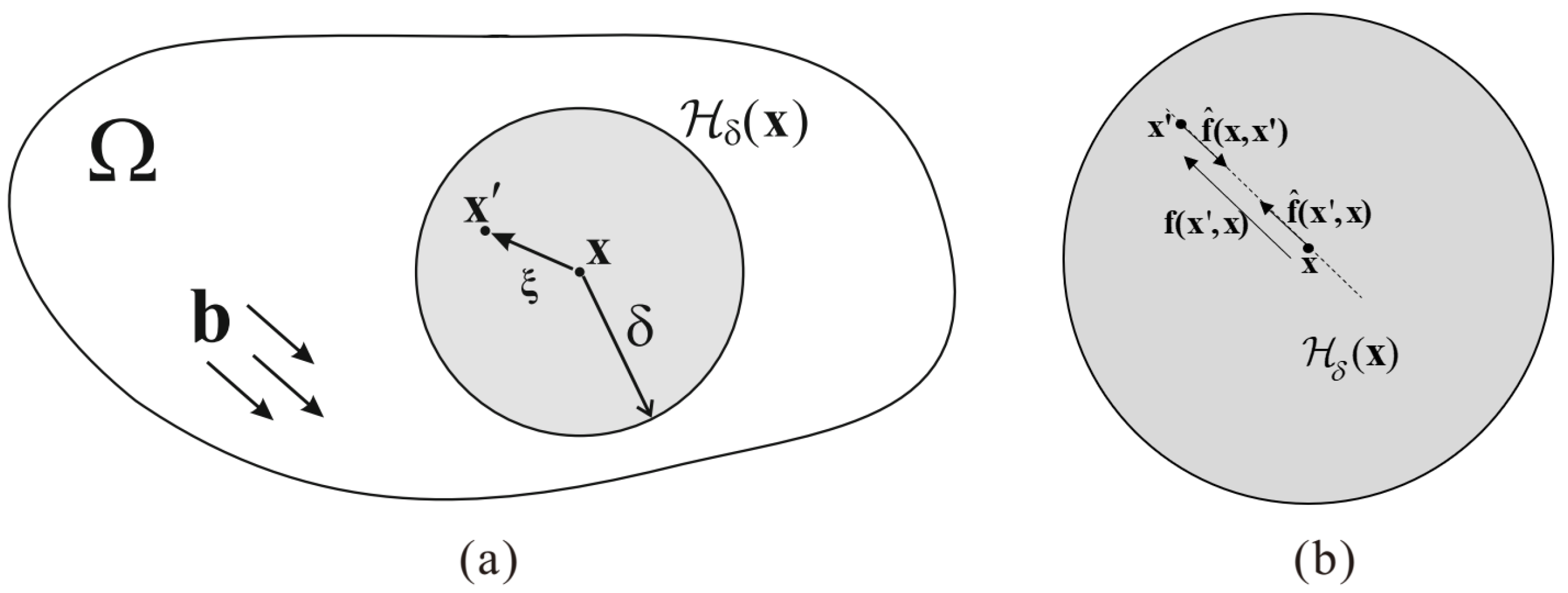
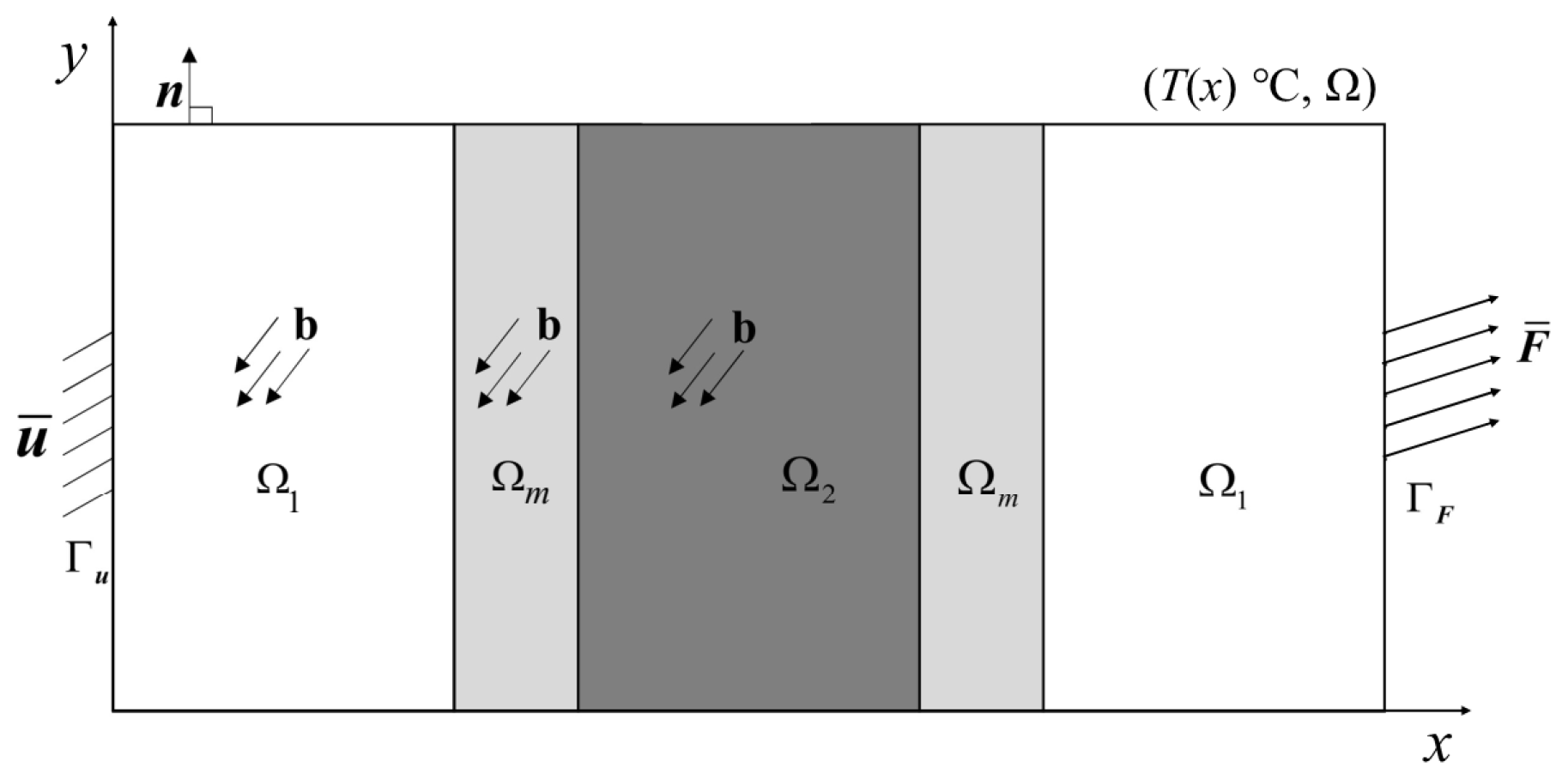
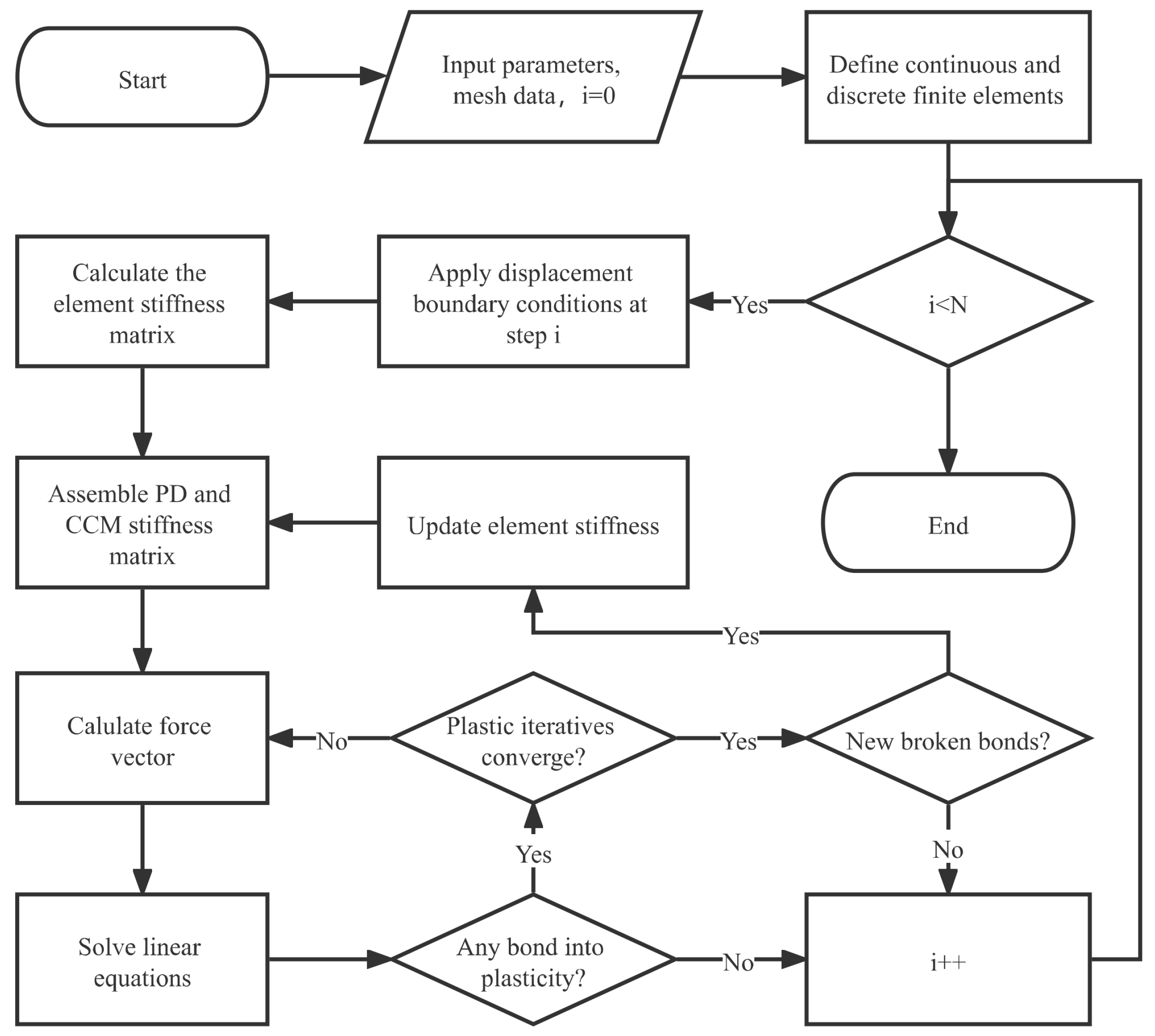

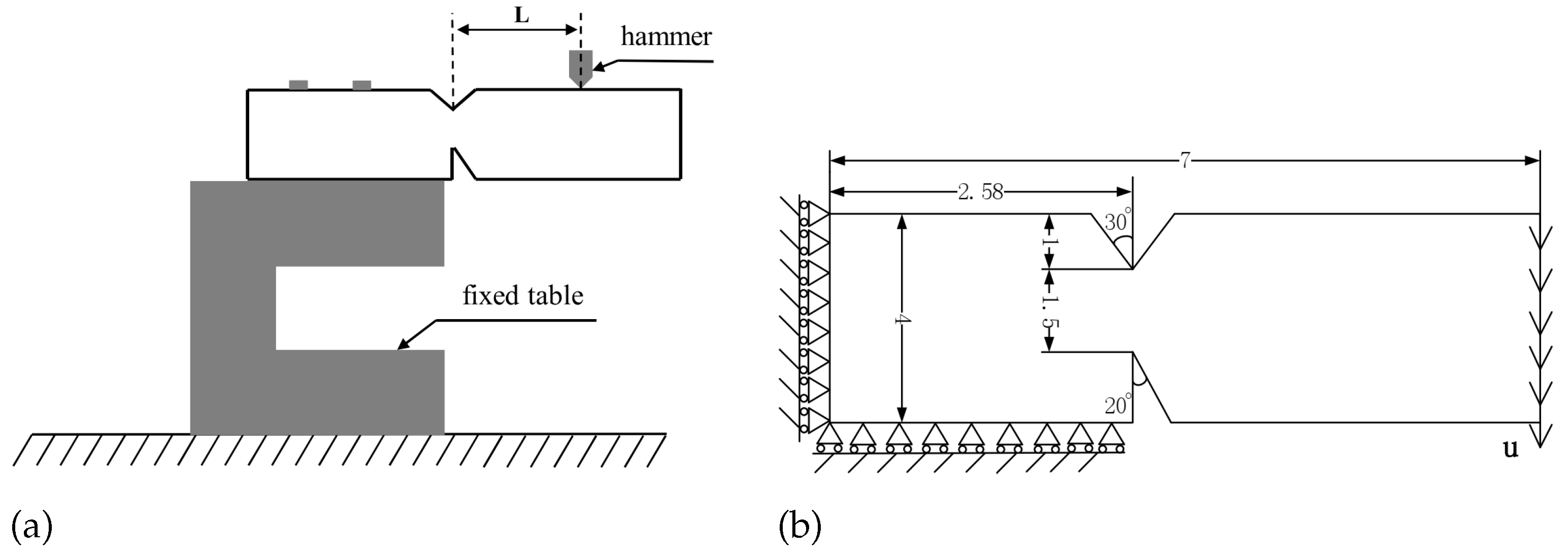

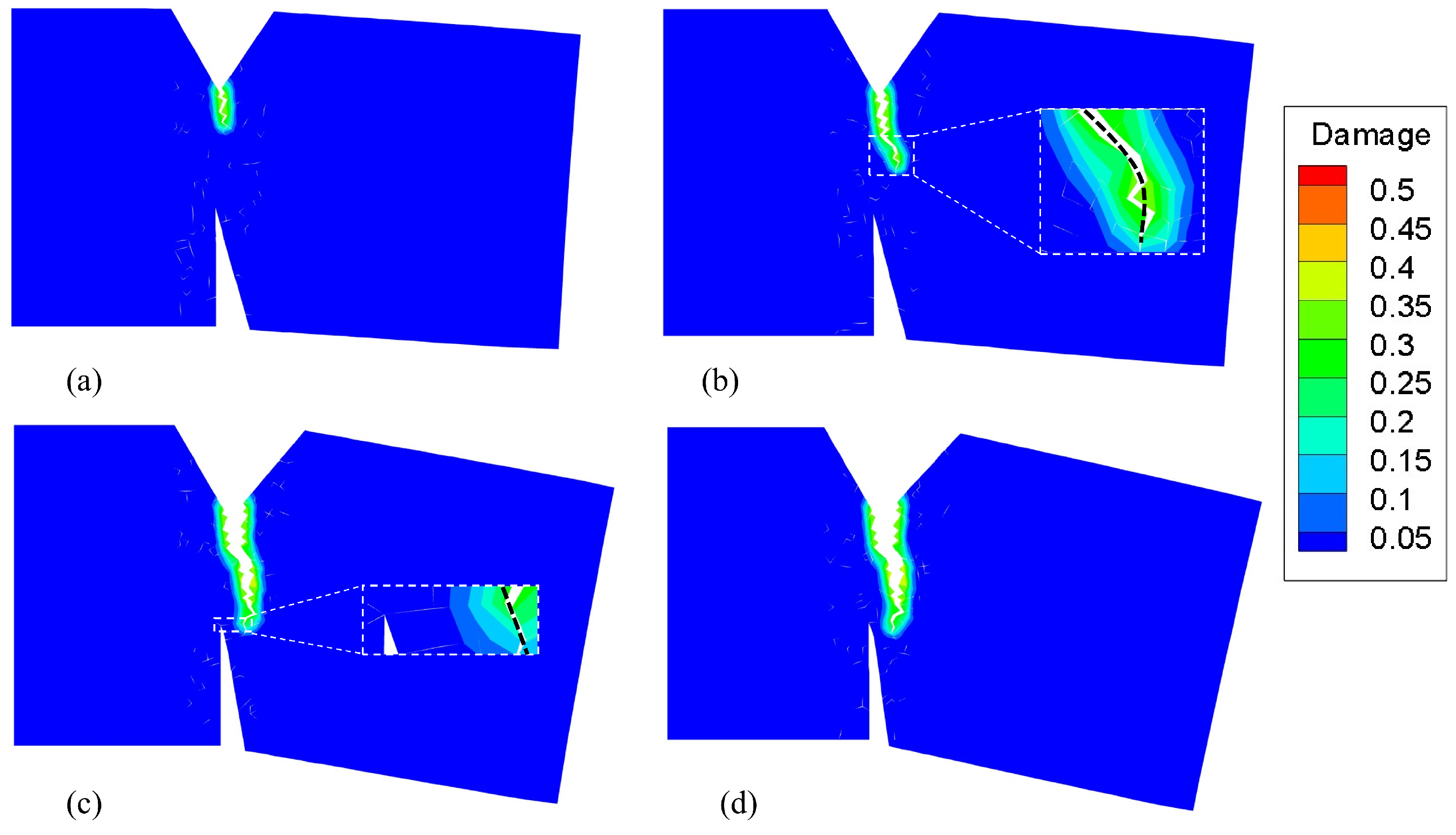
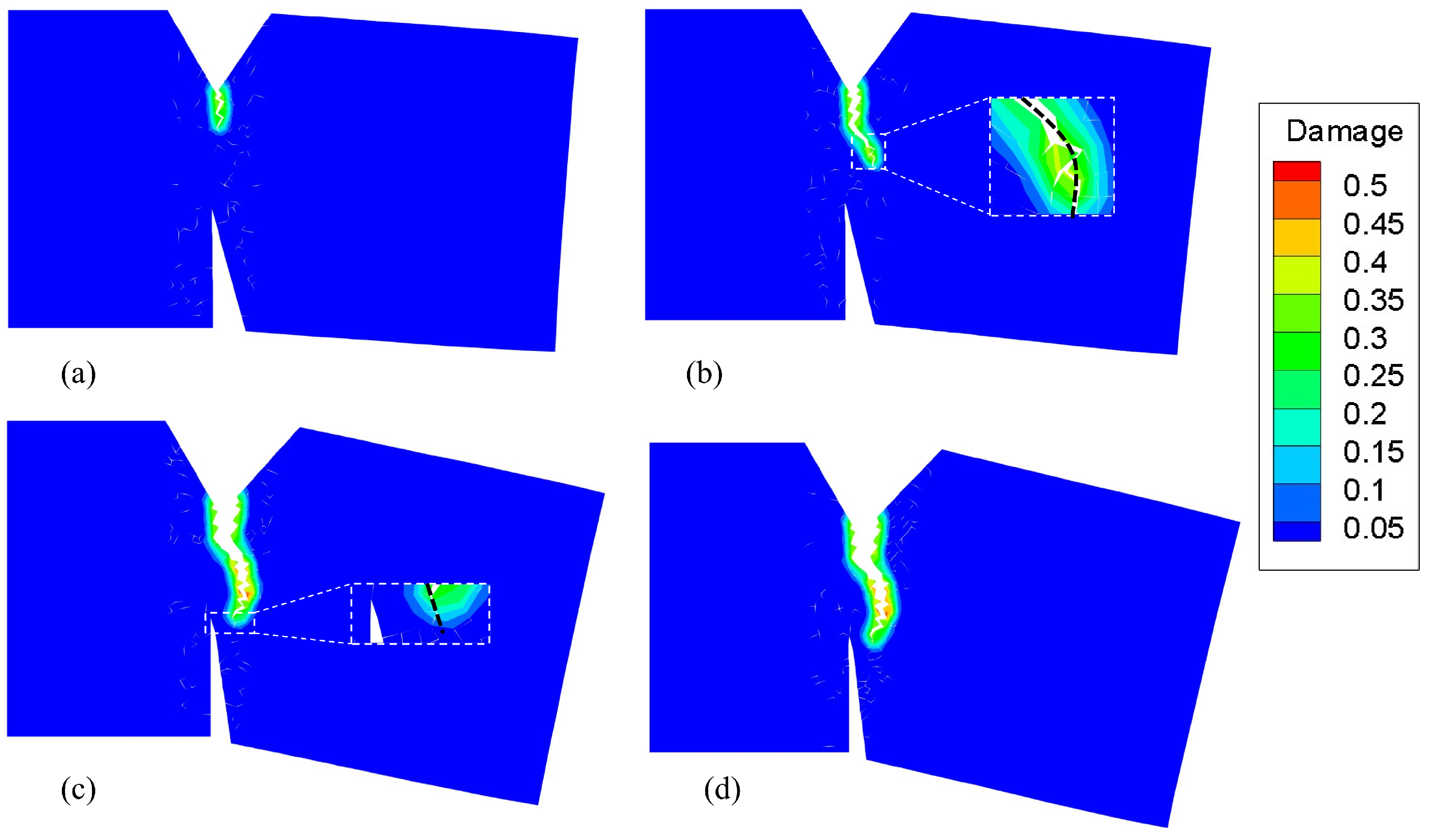
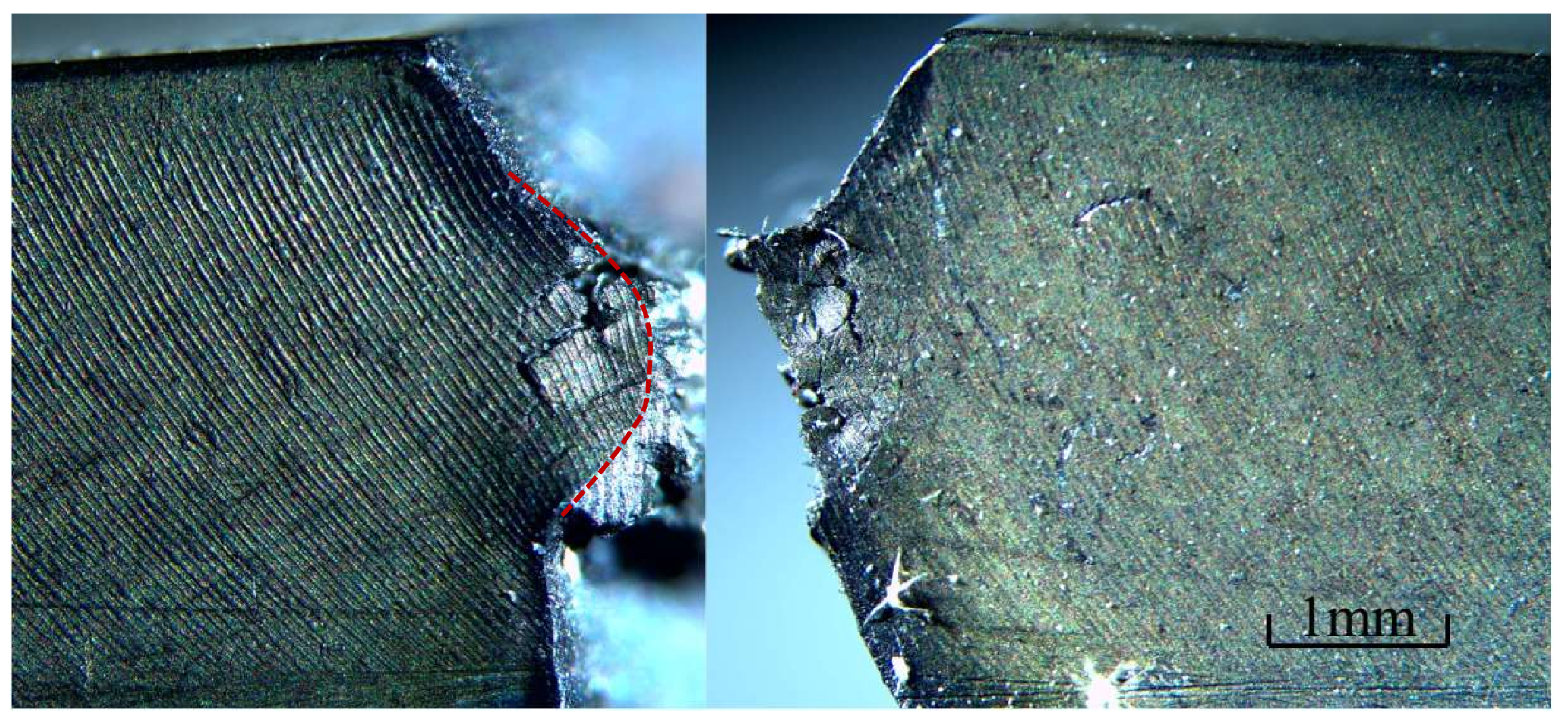
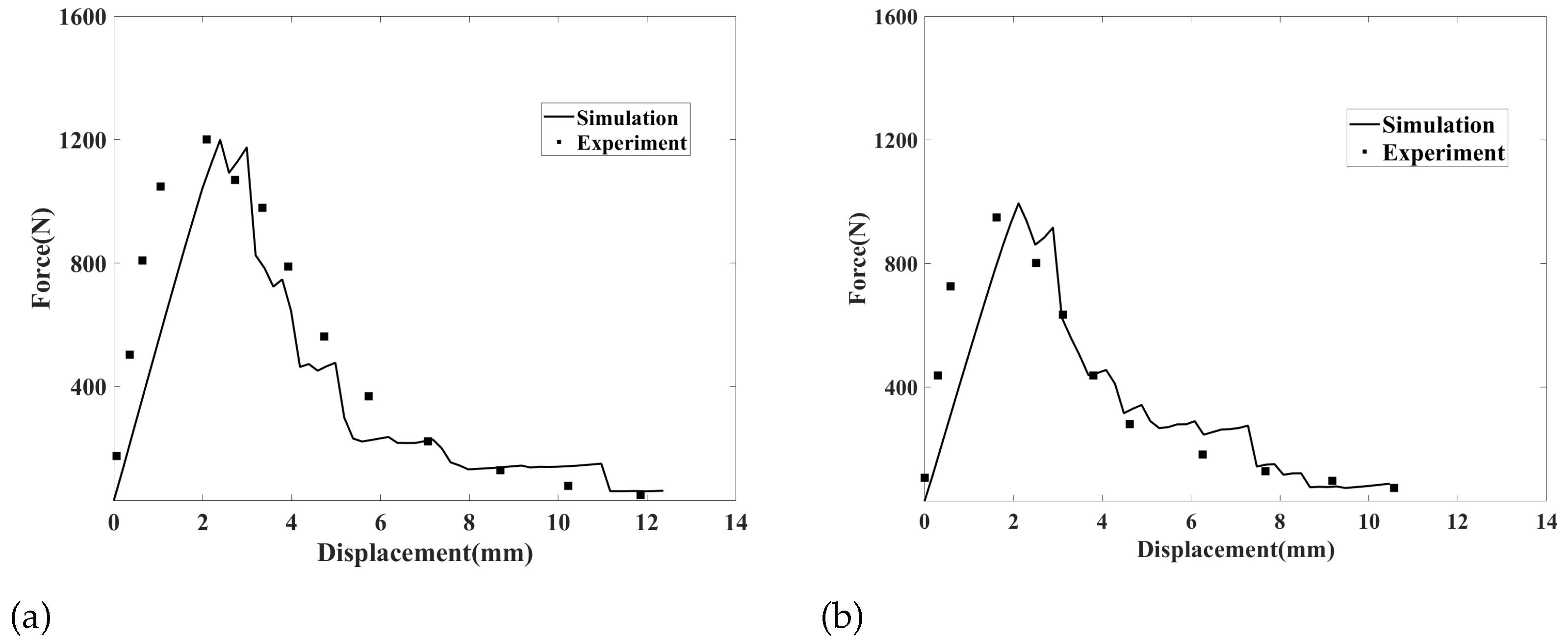




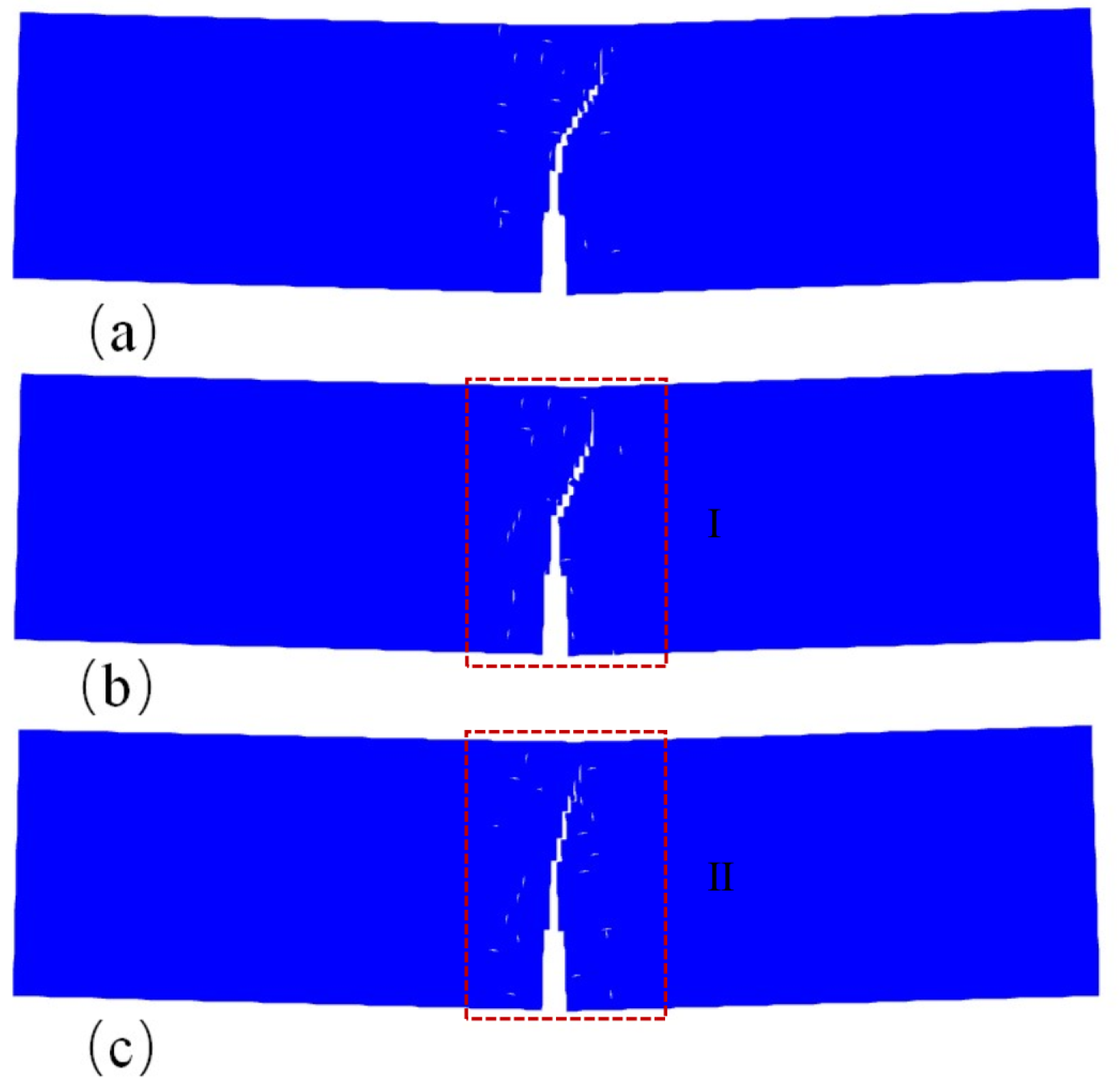
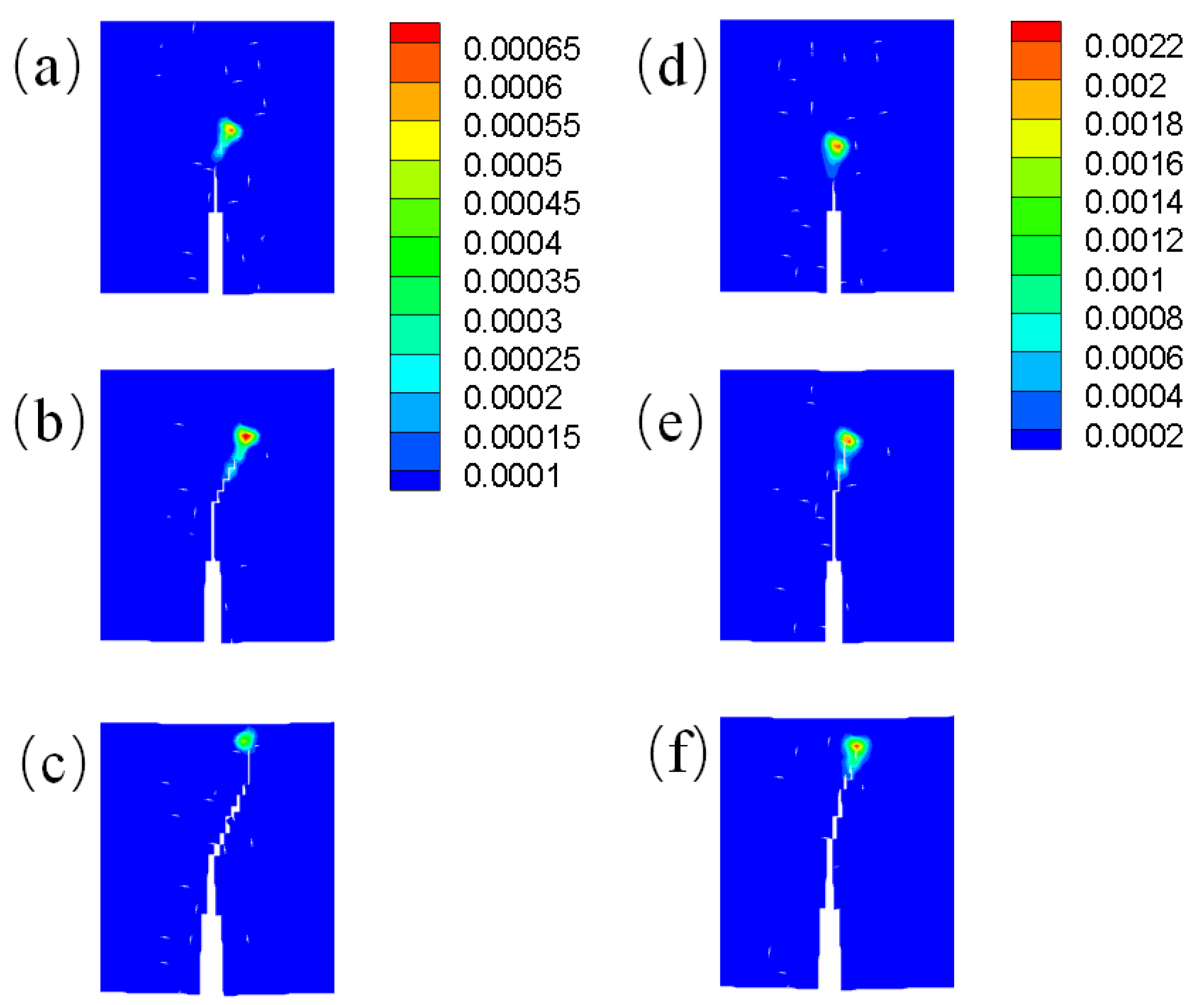
| Temperature | Young’s Modulus (GPa) | Coefficient of Thermal Expansion () | Increments | ||
|---|---|---|---|---|---|
| 800 ℃ | 147 | 15.1 | 0.04 | 0.1 | 50 |
| 900 ℃ | 121 | 15.3 | 0.04 | 0.12 | 50 |
Disclaimer/Publisher’s Note: The statements, opinions and data contained in all publications are solely those of the individual author(s) and contributor(s) and not of MDPI and/or the editor(s). MDPI and/or the editor(s) disclaim responsibility for any injury to people or property resulting from any ideas, methods, instructions or products referred to in the content. |
© 2023 by the authors. Licensee MDPI, Basel, Switzerland. This article is an open access article distributed under the terms and conditions of the Creative Commons Attribution (CC BY) license (https://creativecommons.org/licenses/by/4.0/).
Share and Cite
Liu, S.; Han, F.; Deng, X.; Lin, Y. Thermomechanical Peridynamic Modeling for Ductile Fracture. Materials 2023, 16, 4074. https://doi.org/10.3390/ma16114074
Liu S, Han F, Deng X, Lin Y. Thermomechanical Peridynamic Modeling for Ductile Fracture. Materials. 2023; 16(11):4074. https://doi.org/10.3390/ma16114074
Chicago/Turabian StyleLiu, Shankun, Fei Han, Xiaoliang Deng, and Ye Lin. 2023. "Thermomechanical Peridynamic Modeling for Ductile Fracture" Materials 16, no. 11: 4074. https://doi.org/10.3390/ma16114074
APA StyleLiu, S., Han, F., Deng, X., & Lin, Y. (2023). Thermomechanical Peridynamic Modeling for Ductile Fracture. Materials, 16(11), 4074. https://doi.org/10.3390/ma16114074






